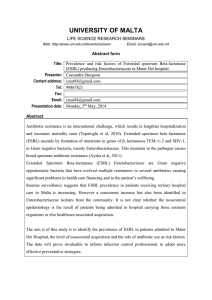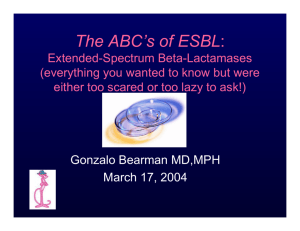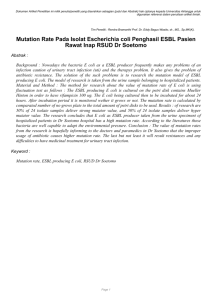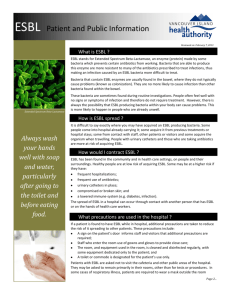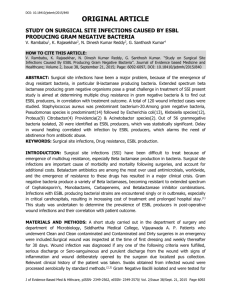Document 13309838
advertisement
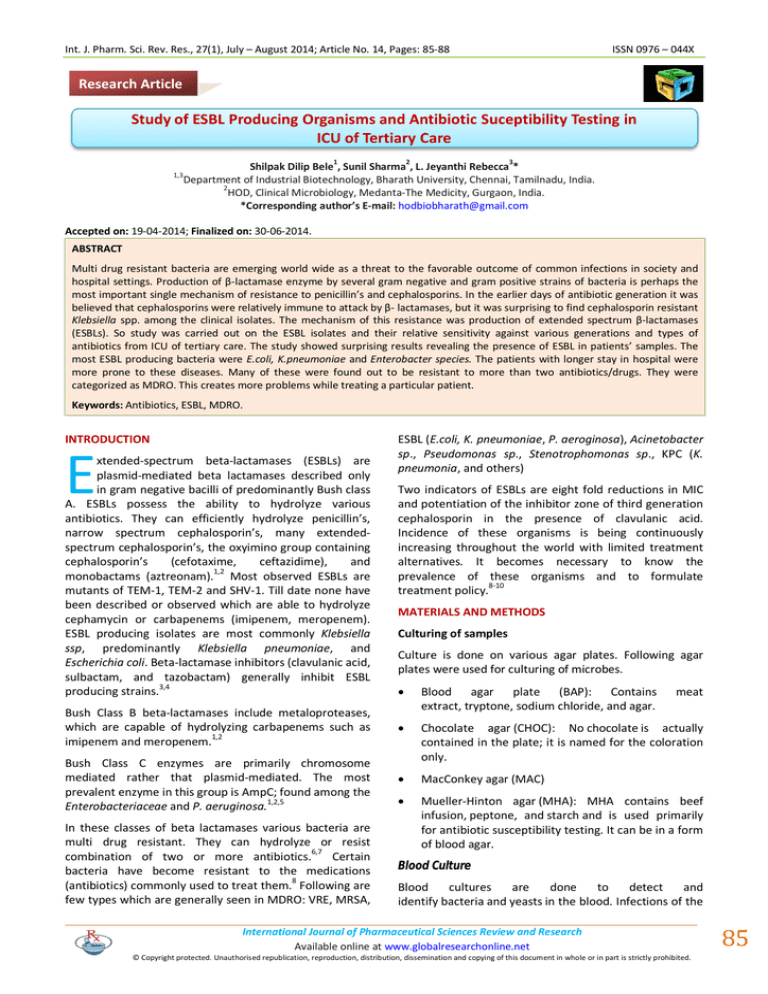
Int. J. Pharm. Sci. Rev. Res., 27(1), July – August 2014; Article No. 14, Pages: 85-88 ISSN 0976 – 044X Research Article Study of ESBL Producing Organisms and Antibiotic Suceptibility Testing in ICU of Tertiary Care 1 1,3 2 3 Shilpak Dilip Bele , Sunil Sharma , L. Jeyanthi Rebecca * Department of Industrial Biotechnology, Bharath University, Chennai, Tamilnadu, India. 2 HOD, Clinical Microbiology, Medanta-The Medicity, Gurgaon, India. *Corresponding author’s E-mail: hodbiobharath@gmail.com Accepted on: 19-04-2014; Finalized on: 30-06-2014. ABSTRACT Multi drug resistant bacteria are emerging world wide as a threat to the favorable outcome of common infections in society and hospital settings. Production of β-lactamase enzyme by several gram negative and gram positive strains of bacteria is perhaps the most important single mechanism of resistance to penicillin’s and cephalosporins. In the earlier days of antibiotic generation it was believed that cephalosporins were relatively immune to attack by β- lactamases, but it was surprising to find cephalosporin resistant Klebsiella spp. among the clinical isolates. The mechanism of this resistance was production of extended spectrum β-lactamases (ESBLs). So study was carried out on the ESBL isolates and their relative sensitivity against various generations and types of antibiotics from ICU of tertiary care. The study showed surprising results revealing the presence of ESBL in patients’ samples. The most ESBL producing bacteria were E.coli, K.pneumoniae and Enterobacter species. The patients with longer stay in hospital were more prone to these diseases. Many of these were found out to be resistant to more than two antibiotics/drugs. They were categorized as MDRO. This creates more problems while treating a particular patient. Keywords: Antibiotics, ESBL, MDRO. INTRODUCTION E xtended-spectrum beta-lactamases (ESBLs) are plasmid-mediated beta lactamases described only in gram negative bacilli of predominantly Bush class A. ESBLs possess the ability to hydrolyze various antibiotics. They can efficiently hydrolyze penicillin’s, narrow spectrum cephalosporin’s, many extendedspectrum cephalosporin’s, the oxyimino group containing cephalosporin’s (cefotaxime, ceftazidime), and monobactams (aztreonam).1,2 Most observed ESBLs are mutants of TEM-1, TEM-2 and SHV-1. Till date none have been described or observed which are able to hydrolyze cephamycin or carbapenems (imipenem, meropenem). ESBL producing isolates are most commonly Klebsiella ssp, predominantly Klebsiella pneumoniae, and Escherichia coli. Beta-lactamase inhibitors (clavulanic acid, sulbactam, and tazobactam) generally inhibit ESBL producing strains.3,4 ESBL (E.coli, K. pneumoniae, P. aeroginosa), Acinetobacter sp., Pseudomonas sp., Stenotrophomonas sp., KPC (K. pneumonia, and others) Two indicators of ESBLs are eight fold reductions in MIC and potentiation of the inhibitor zone of third generation cephalosporin in the presence of clavulanic acid. Incidence of these organisms is being continuously increasing throughout the world with limited treatment alternatives. It becomes necessary to know the prevalence of these organisms and to formulate treatment policy.8-10 MATERIALS AND METHODS Culturing of samples Culture is done on various agar plates. Following agar plates were used for culturing of microbes. Bush Class B beta-lactamases include metaloproteases, which are capable of hydrolyzing carbapenems such as imipenem and meropenem.1,2 Blood agar plate (BAP): Contains extract, tryptone, sodium chloride, and agar. meat Bush Class C enzymes are primarily chromosome mediated rather that plasmid-mediated. The most prevalent enzyme in this group is AmpC; found among the 1,2,5 Enterobacteriaceae and P. aeruginosa. Chocolate agar (CHOC): No chocolate is actually contained in the plate; it is named for the coloration only. MacConkey agar (MAC) In these classes of beta lactamases various bacteria are multi drug resistant. They can hydrolyze or resist 6,7 combination of two or more antibiotics. Certain bacteria have become resistant to the medications 8 (antibiotics) commonly used to treat them. Following are few types which are generally seen in MDRO: VRE, MRSA, Mueller-Hinton agar (MHA): MHA contains beef infusion, peptone, and starch and is used primarily for antibiotic susceptibility testing. It can be in a form of blood agar. Blood Culture Blood cultures are done to detect and identify bacteria and yeasts in the blood. Infections of the International Journal of Pharmaceutical Sciences Review and Research Available online at www.globalresearchonline.net © Copyright protected. Unauthorised republication, reproduction, distribution, dissemination and copying of this document in whole or in part is strictly prohibited. 85 © Copyright pro Int. J. Pharm. Sci. Rev. Res., 27(1), July – August 2014; Article No. 14, Pages: 85-88 ISSN 0976 – 044X bloodstream are most commonly caused by bacteria (bacteremia), but can also be caused by yeasts or other fungi or by a virus. The source of the infection is typically a specific site within the body. If a person's immune system cannot contain an infection at its source, such as the bladder or kidneys from a urinary tract infection, the infection may spread into the bloodstream and be carried throughout the body, infecting other organs and causing a serious and sometimes lifethreatening systemic infection. than10 mm increase in the zone of inhibition on the clavulanate containing MHA plate indicated ESBL production. Urine Culture MIC reduction test2 The urine culture test detects and identifies bacteria and yeast in the urine. Urine is produced by the kidneys, two fist-sized organs located on either side of the spine at the base of the ribcage. Urine is generally sterile, but sometimes bacteria or, more rarely, yeast can move from the skin outside the urethra and migrate back up the urinary tract to cause a urinary tract infection (UTI). An 8 fold reduction in the MIC of cephalosporin in the presence of clavulanic acid indicated production of ESBL. Sputum Sputum cultures detect the presence of pathogenic bacteria in those who have bacterial pneumonia and other lower respiratory tract infections. Bacteria in the sample are identified and susceptibility testing is performed to guide antimicrobial treatment. Methods Double disc synergy test 12 Disk approximation test10 Cefoxitin (inducer) disc was placed at a distance of 2.5 cm from cephalosporin disc. Production of inducible βlactamase is indicated by flattening of the zone of inhibition of the cephalosporin disc towards inducer disc by >1 mm. E Test16 The E test ESBL strip carries two gradients, on the one end, ceftazidime and on the opposite end ceftazidime plus clavulanic acid. MIC was interpreted as the point of intersection of the inhibition ellipse with the E test strip edge. Ratio of ceftazidime MIC and ceftazidime clavulanic acid MIC equal to or greater than 8 indicates the presence of ESBL. Vitek 2 The VITEK® 2 ESBL Test is a confirmatory test for those ESBLs inhibited by clavulanic acid, and it utilizes cefepime, cefotaxime, and ceftazidime, with and without clavulanic acid, to determine a positive or negative result. RESULTS AND DISCUSSION In this test, discs of third generation cephalosporin’s and augmentin were kept 30mm apart from center to center on inoculated Mueller-Hinton Agar (MHA). A clear extension of the edge of the inhibition zone of cephalosporin towards augmentin disc was interpreted as positive for ESBL production. Three dimensional test13 This test provides the advantage of simultaneous determination of antibiotic susceptibility and β-lactamase substrate profile. Inoculum produced in this method contains between 109 and 1010 CFU/mL of cells that actively produce β-lactamase. Two types of inocula were prepared one disc diffusion test inoculum (optical density equal to that of 0.5 McFarland standard) and a three dimensional inoculum (contain between 109 and 1010 CFU of cells). Plate was inoculated by disc diffusion procedure. A circular slit was cut on the agar 4mm inside the position at which the antibiotic discs were placed. Conventional (two dimensional) disc diffusion susceptibility test results were measured according to the recommendations of NCCLS. Distortion or discontinuity in the circular inhibition zone was interpreted as positive for ESBL production. Inhibitor potentiated disc diffusion test14 Sputum and Urine Total samples : 402 Samples with growth in culture : 89 ESBL + : 10 Table 1: Sputum and urine samples with isolated microorganisms Organism (Type of bacteria isolated) No. of organisms seen P. aeruguinosa 12 Enterobacter cloacae 10 E. coli 10 K. pneumonia 19 Acinetobacter baumannii 8 Proteus mirabilis 1 Serratia liquefaciens 1 Enterococcus faecium 2 Enterococcus faecalis 1 Candida 22 Staphylococcus aureus 2 Micrococcus 1 Cephalosporin disc was placed on clavulanate containing and without clavulanate containing MHA plates. More International Journal of Pharmaceutical Sciences Review and Research Available online at www.globalresearchonline.net © Copyright protected. Unauthorised republication, reproduction, distribution, dissemination and copying of this document in whole or in part is strictly prohibited. 86 © Copyright pro Int. J. Pharm. Sci. Rev. Res., 27(1), July – August 2014; Article No. 14, Pages: 85-88 The microbial flora of sputum and urine samples is listed in Table 1. The same data in bar chart is shown in Figure 1. Figure 1: No. of microorganisms observed in sputum and urine samples Total Positive samples: 89 ISSN 0976 – 044X Table 4: Positive samples of blood isolated with different microorganisms Organism (Type of bacteria isolated) No. of organisms seen P. aeruguinosa 1 Stenotrophomonas maltophilia 2 E. coli 5 K. pneumoniae 3 Acinetobacter baumannii 9 Coagulase negative staphylococcus 8 Elizabethkingia meningoseptica 1 Enterococcus faecium 2 Staphylococcus hominis 1 Candida 2 Staphylococcus aureus 1 Stphylococcus haemolyticus 3 Stphylococcus epidermis 1 Sputum Total no. of samples tested: 221 ESBL + : 7 Table 2: ESBL producing bacteria among the sputum samples tested Organism Number of ESBL identified E.coli 4 K.pneumoniae 2 Enterobacter 1 Table 2 shows the list of ESBL producing bacteria in the sputum. E. coli was found to be in more number than the other two. The same data is depicted in the form of pie chart (Fig 3). Table 3 shows the list of ESBL producing bacteria in the urine. E. coli was found to be in more number than the other two in urine samples also. Urine Total no. of samples tested: 181 ESBL + : 3 Table 3: ESBL producing microorganisms from urine Organism Number of ESBL identified E.coli 2 K.pneumoniae 1 Table 4 shows the list of microorganisms present in the blood sample. E.coli was the major ESBL producing organism in the blood samples also (Table 5, Figure 2). Blood Total no. of samples tested: 441 Figure 2: No. of microorganisms observed in the blood samples after culture Table 5: ESBL producing bacteria from blood culture samples Organism Number of ESBL identified E.coli 2 K.pneumoniae 1 The samples from Intensive Care Unit of Tertiary Care Hospital were tested form 13th May- 13th July 2010 (221sputum, 181- urine, 441- blood). The samples were analyzed on different agar plates as mentioned previously. The samples with positive results were processed further for identification of microorganisms. These microbes were bacteria and fungi. The identification revealed particular bacteria with which the patient was infected. Later, the bacteria were tested with different methods to identify the ESBL producing one. It was observed that percentage of E. coli producing ESBL was highest followed by K. pneumoniae. The E.coli percentage in sputum was 57, in urine 67 and n blood again 67. The percentage of K. pneumoniae in sputum International Journal of Pharmaceutical Sciences Review and Research Available online at www.globalresearchonline.net © Copyright protected. Unauthorised republication, reproduction, distribution, dissemination and copying of this document in whole or in part is strictly prohibited. 87 © Copyright pro Int. J. Pharm. Sci. Rev. Res., 27(1), July – August 2014; Article No. 14, Pages: 85-88 was 29, in urine 33 and in blood 33. Enterobacter spp. was found only in sputum with 14%. The total percentage of ESBLs in blood was very low i.e. 0.68, in urine 1.65 and in sputum it was the highest 3.16. The microbes showed variety of susceptibility against 46 different antibiotics such as amikacin, Ampicillin, Gentamycin, rifamycin, ciprofloxacin, oxacillin, pipercillin etc. Different strains of same bacteria were observed during analysis. It was observed that many of these organisms were resistant to more than 2 drugs, thus they were classified as Multi-Drug Resistant Organism (MDRO). They were resistant to penicillin’s, all 3rd generation cephalosporin’s, monabactems (Aztreonam), cefepime and tobramycin. Most of the bacteria were found to be sensitive against carbapenems (Imipenem, meropenem, ertapenem). They were also susceptible to beta lactamase inhibitor (Pipercillin/ Tazobactum), quinupristn/dalfopristin, trimethoprim/sulfamethaxazole and colistin. The combination of different antibiotics was a better treatment observed against these bacteria So, carbapenems is the best available treatment for the patients suffering from diseases with ESBLs. an important component of antimicrobial therapy in high risk wards. Knowledge of resistance pattern of bacterial strains in a geographical area will help to guide the appropriate and judicious antibiotic use. There is possibility that the restricted use can lead to the withdrawal of selective pressure and resistant bacteria will no longer have survival advantage in such settings. REFERENCES 1. Neelam Taneja, Pooja Rao, Jitender Arora and Ashok Dogra; Occurrence Of ESBL & Amp-C B-Lactamases & Susceptibility To Newer Antimicrobial Agents In Complicated UTI, Indian J Med Res, 127, 2008, 85-88. 2. Debasrita Chakraborty, Saikat Basu, Satadal Das, Study On Some Gram Negative Multi Drug Resistant Bacteria And Their Molecular Characterization, Asian J Pharm Clin Res, 4(1), 2011, 108-112. 3. Irith Wiegand, Heinrich K. Geiss, Dietrich Mack, Enno Stürenbur, Harald Seifert, Detection Of Extended-Spectrum Beta-Lactamases Among Enterobacteriaceae By Use Of Semiautomated Microbiology Systems And Manual Detection Procedures, J Clin Microbiol., 45(4), 2007, 11671174. 4. U Chaudhary, R Aggarwal, Extended Spectrum -Lactamases (ESBL) - An Emerging Threat To Clinical Therapeutics, Indian Journal Of Medical Microbiology, 22(2), 2004, 75-80. 5. Sanders WE Jr, Sanders CC, Enterobacter Spp.: Pathogens Poised to Flourish At The Turn Of The Century, Clin Microbiol Rev., 10(2), 1997, 220-241. 6. Debasrita Chakraborty, Saikat Basu, Satadal Das, A Study on Infections Caused By Metallo Beta Lactamase Producing Gram Negative Bacteria in Intensive Care Unit Patients, American Journal of Infectious Diseases, 6(2), 2010, 34-39. 7. Patricia A. Bradford, Extended-Spectrum Β-Lactamases In The 21st Century: Characterization, Epidemiology, And Detection Of This Important Resistance Threat, Clin Microbiol Rev., 14(4), 2001, 933-951. 8. S Bhattacharya, Esbl- From Petri Dish To The Patient, Indian Journal Of Medical Microbiology, 24(1), 2006, 20-24. 9. Chen-Hsiang Lee, Lin-Hui Su, Ya-Fen Tang, Jien-Wei Liu, Treatment of Esbl-Producing Klebsiella Pneumoniae Bacteraemia With Carbapenems Or Flomoxef: A Retrospective Study And Laboratory Analysis Of The Isolates, Journal Of Antimicrobial Chemotherapy, 58, 2006, 1074–1077. CONCLUSION ESBL producing organisms pose a major problem for clinical therapeutics. The incidence of ESBL producing strains among clinical isolates has been steadily increasing over the past few years resulting in limitation of therapeutic options. Initially restricted to hospital acquired infections, they have also been isolated from infections in outpatients. Major outbreaks involving ESBL strains have been reported from all over the world, thus making them emerging pathogens. The routine susceptibility tests done by clinical laboratories fail to detect ESBL positive strains and can erroneously detect isolates sometimes to be sensitive to any of the broad spectrum cephalosporin like cefotaxime, ceftazidime, ceftriaxone, only the hospitals with modern techniques are able to detect ESBLs. With the spread of ESBL producing strains in hospitals all over the world, it is necessary to know the prevalence of ESBL positive strains in a hospital so as to formulate a policy of empirical therapy in high risk units where infections due to resistant organisms is much higher. Equally, important is the information on an isolate from a patient to avoid misuse of extended spectrum cephalosporin’s, which still remain ISSN 0976 – 044X 10. ESBLS – A Threat to Human And Animal Health, Report By The Joint Working Group Of DARC And ARHAI. Source of Support: Nil, Conflict of Interest: None. International Journal of Pharmaceutical Sciences Review and Research Available online at www.globalresearchonline.net © Copyright protected. Unauthorised republication, reproduction, distribution, dissemination and copying of this document in whole or in part is strictly prohibited. 88 © Copyright pro
